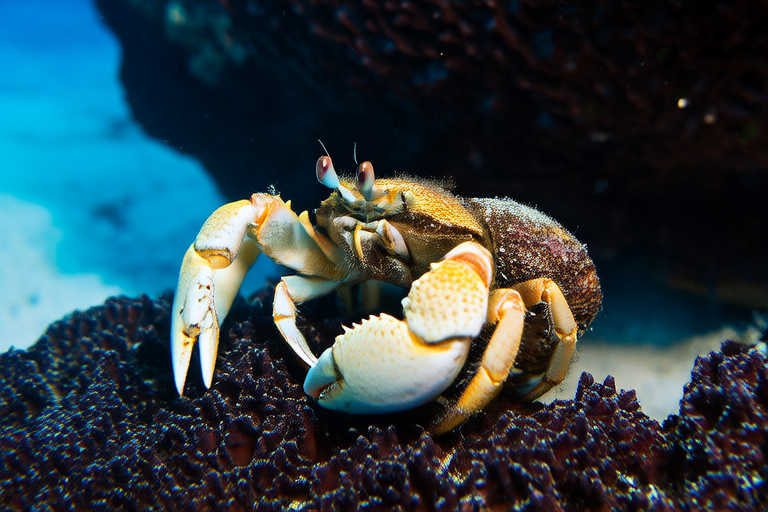Hermit Crabs: A Comprehensive Guide
Hermit crabs are fascinating creatures that have captivated the hearts of many pet enthusiasts. Their unique habitat, dietary needs, and social behaviors make them intriguing subjects of study. This guide will explore everything you need to know about hermit crabs, from their natural environment to their role in marine ecosystems, and provide valuable insights into their care as pets.
The Unique Habitat of Hermit Crabs
Hermit crabs are primarily found in tropical and subtropical coastal areas, where they thrive in sandy or muddy substrates. These environments provide ample hiding spots and food sources, making them ideal for hermit crabs. In the wild, they can be found in shallow waters, rocky shores, and mangrove swamps. They are highly adaptable and can survive in various conditions, including freshwater, saltwater, and brackish water. However, it’s crucial to replicate these conditions as closely as possible when keeping hermit crabs as pets.
Dietary Needs of Hermit Crabs
Hermit crabs are omnivores, meaning they eat both plant and animal matter. In the wild, their diet consists of algae, decaying organic matter, and small marine organisms. As pets, they require a balanced diet that includes fresh fruits, vegetables, and protein-rich foods such as fish flakes, shrimp, and mealworms. It’s essential to avoid feeding them processed human foods, as these can be harmful to their health. Additionally, providing calcium-rich foods like crushed eggshells or cuttlebone can help maintain strong exoskeletons.
Social Behaviors and Shell-Swapping Habits
Hermit crabs are social animals that live in large groups in the wild. They communicate through vibrations and chemical signals, and their interactions can be observed through their movements and behaviors. One of the most fascinating aspects of hermit crab behavior is their shell-swapping habit. When a hermit crab outgrows its current shell, it searches for a new one that better fits its size. This process can involve multiple crabs competing for the same shell, leading to an interesting display of strength and agility. As pets, hermit crabs should have access to a variety of shells to ensure they can find a suitable replacement when needed.
How Hermit Crabs Contribute to Marine Ecosystems
Hermit crabs play a vital role in marine ecosystems by breaking down dead plant and animal matter, helping to recycle nutrients back into the environment. They also serve as prey for larger marine animals, contributing to the food chain. Additionally, their burrowing activities help aerate the substrate, promoting healthy plant growth and preventing erosion. By maintaining a stable ecosystem, hermit crabs support the survival of other species and contribute to the overall health of marine environments.
Common Myths Versus Realities Regarding Hermit Crab Care
There are several misconceptions about hermit crab care that can lead to improper husbandry practices. One common myth is that hermit crabs only require sand as a substrate. While sand is an important component of their environment, it should be supplemented with other materials such as coconut fiber, bark, or moss to provide varied textures and moisture levels. Another myth is that hermit crabs don’t need a humid environment. In reality, hermit crabs require high humidity levels to prevent dehydration and facilitate molting. Proper humidity levels can be maintained by misting the enclosure regularly and providing a water dish.
Tips for Setting Up an Optimal Living Space
Creating an optimal living space for hermit crabs involves replicating their natural environment as closely as possible. Start by selecting an appropriate enclosure, such as a glass aquarium or plastic storage container, with a secure lid to prevent escapes. The enclosure should be at least four times the length of the largest crab to allow for adequate movement and exploration. Provide a mix of substrates, including sand, coconut fiber, and bark, to create a varied and stimulating environment. Incorporate hiding spots, such as cork bark, driftwood, or commercially available shelters, to give your hermit crabs a sense of security. Finally, include a shallow water dish and a calcium source, such as cuttlebone or crushed eggshells, to promote healthy molting and shell maintenance.
Maintaining Hermit Crab Health
Maintaining hermit crab health requires regular monitoring and care. Monitor the temperature and humidity levels within the enclosure, ensuring they remain consistent and appropriate for hermit crabs. Clean the enclosure regularly, removing any uneaten food or waste to prevent bacterial growth. Offer a balanced diet that includes fresh fruits, vegetables, and protein-rich foods, and provide a calcium source to support strong exoskeletons. Regularly check the condition of the shells, replacing any that become damaged or too small. By following these guidelines, you can help ensure the long-term health and well-being of your hermit crabs.
Understanding Nocturnal Nature and Sensitive Antennae
Hermit crabs are primarily nocturnal, meaning they are most active during the night. Understanding this behavior is crucial for providing proper care and minimizing stress. During the day, hermit crabs may appear inactive or sluggish, but this does not necessarily indicate poor health. To accommodate their nocturnal nature, it’s recommended to minimize disturbances during the day and provide a quiet, dimly lit environment. Hermit crabs also have highly sensitive antennae, which they use to navigate their surroundings and detect potential threats. Avoid handling your hermit crabs roughly or placing objects near their antennae, as this can cause distress.
Conclusion
Hermit crabs are fascinating creatures with unique habitats, dietary needs, and social behaviors. By understanding their natural environment, dietary requirements, and social dynamics, we can provide optimal care for these amazing pets. It’s essential to dispel common myths about hermit crab care and follow best practices to ensure their long-term health and well-being. With the right setup and care, hermit crabs can thrive in captivity, bringing joy and wonder to their owners for years to come.
